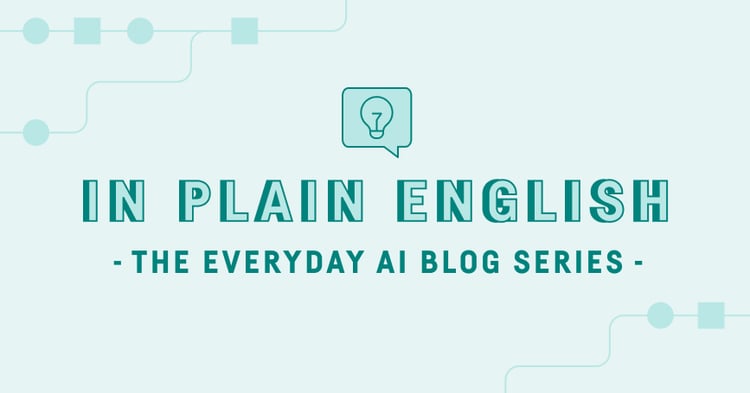In today's data-driven landscape, businesses are increasingly relying on AI and machine learning (ML) to gain insights, make predictions, and automate processes. As these technologies become more prevalent — especially with Generative AI evolving and advancing as quickly as it is — it's crucial for business leaders (who are analytics and AI enthusiasts!) to understand the nuances behind model optimization, particularly the concept of fine-tuning.
In our latest “In Plain English” blog series meant for non-technical business leaders, we unpack what fine-tuning a standard ML model entails, why it’s important, and key challenges and considerations. Stay tuned for our future article that focuses on the specificities of fine-tuning Large Language Models (LLMs).

Understanding Fine-Tuning
At its core, fine-tuning refers to the process of adjusting a pre-trained ML model to better suit a specific task, dataset, or use case. Think of it as a form of customization or optimization tailored to the unique requirements of a particular problem domain. A real-world example could be in an image classification use case, fine-tuning a standard, generic computer vision model to adapt it to your specific domain (i.e., defect detection in manufacturing).
When a model is pre-trained, it has already learned useful features and patterns from a vast amount of data. However, these generic models may not perform optimally when applied directly to new, domain-specific tasks or datasets.
Fine-tuning addresses this issue by fine-tuning the model's parameters to adapt to the nuances of the target task or dataset. It is also especially beneficial when computational resources are limited or relevant data is scarce. It is important to note that fine-tuning a traditional ML algorithm works differently than fine-tuning an LLM — significant computational resources, training data, and AI expertise are required — so be sure to tune in for part two of this article for the differences!
Why Fine-Tuning Matters
Fine-tuning plays a critical role in maximizing the performance of standard ML models for real-world applications. Here's why it matters:
- Improved Domain Adaptation Performance on Specialized Tasks: By fine-tuning pre-trained models, businesses can achieve higher accuracy and better results on specific tasks compared to training from scratch. Fine-tuning leverages the knowledge encoded in pre-trained models and refines it to suit the task at hand.
- Efficiency: Fine-tuning is often more time and resource-efficient compared to training models from scratch. Pre-trained models have already undergone extensive training on large datasets, saving businesses valuable time and computational resources.
- Continual Learning: Fine-tuning enables models to evolve over time as new data becomes available or as business requirements change. This adaptability ensures that models remain relevant and effective in dynamic environments.
The Fine-Tuning Process
The fine-tuning process typically involves the following steps:
- Selecting a Pre-Trained Model: Identify a pre-trained model that closely matches the problem domain or task you're addressing. Common choices include models trained on large-scale datasets like ImageNet for computer vision tasks or BERT for natural language processing tasks.
- Data Preparation: Prepare the target dataset by preprocessing and formatting it to match the input requirements of the pre-trained model. This step may involve tasks such as data cleaning, normalization, and feature extraction.
- Fine-Tuning the Model: Train the modified model on the target dataset using techniques such as transfer learning. During training, the model's parameters are adjusted based on the new data, with the objective of minimizing a chosen loss function.
- Evaluation and Validation: Assess the performance of the fine-tuned model using evaluation metrics relevant to the task at hand. This step helps ensure that the model generalizes well to unseen data and produces reliable predictions.
- Iterative Refinement: Fine-tuning is often an iterative process involving multiple rounds of experimentation and refinement. Businesses may need to adjust hyperparameters, try different architectures, or incorporate additional data to achieve the desired performance.
Challenges and Considerations
While fine-tuning offers numerous benefits, it also poses certain challenges and considerations for businesses:
- Data Quality and Quantity: Fine-tuning requires sufficient and high-quality labeled data to achieve optimal performance. Businesses must ensure that their datasets are representative and diverse enough to capture the variability of the target domain.
- Overfitting: Overfitting occurs when a model learns to memorize the training data rather than generalizing patterns. Businesses need to implement strategies such as regularization and cross-validation to prevent overfitting during the fine-tuning process.
- Bias Concerns: Fine-tuned models may inherit biases present in the pre-trained models or the training data, leading to unfair or discriminatory outcomes. Businesses must prioritize fairness, transparency, and ethical considerations when deploying AI systems in real-world settings.
- Resource Constraints: Fine-tuning can be computationally expensive, particularly for large-scale models and datasets. Businesses need to assess their computational resources and infrastructure capabilities to ensure efficient model training and deployment.
Putting It All Together
Fine-tuning is a powerful technique that empowers businesses to leverage pre-trained ML models for specific tasks and domains. By customizing and refining these models, organizations can unlock new opportunities, improve decision-making, and drive innovation across various industries.




